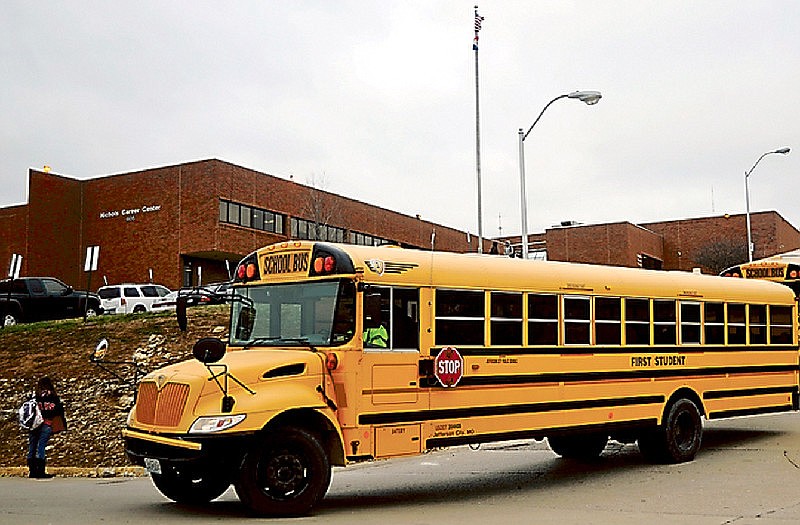The accuracy and clarity of numbers in the Jefferson City Public Schools District's two-high school plan and operating levy issue on the April 4 ballot have raised some doubts and uncertainty in the community.
The two propositions on the ballot are:
A 65-cent property tax increase to pay for a bond issue for construction and renovation costs.
A combined 45-cent levy, which respectively covers operating costs for a second high school (25-cent levy) and operating needs for the current JCPS system (20-cent levy).
The questions being raised circle around two areas:
If the number of students in the district overall and at Jefferson City High School specifically are smaller than in previous years, is the district still overcrowded?
How much more will local taxes increase, beyond those on homes, if voters approve the bond issue and operating levy the district is asking for?
Enrollment
There are fewer students enrolled now than during the 2010-11 school year, according to school district data. At the high school, the student population currently is the smallest since at least the 2008-09 school year, excluding the 2015-16 year when it was 11 students lower still.
But the reality of the implications for the necessity of a second high school is complicated. The short answer is the high school is basically still as overcrowded as it's been for years, even with fewer students than in years past or as projected.
JCPS's Long Range Facility Planning Committee published information in the fall of 2014 that projected a continual increase in student enrollment districtwide, at least through the 2023-24 school year. At that point, the furthest year projected out, the student population is estimated to be somewhere between 9,111-9,657 students.
In 2014, districtwide enrollment for the current school year was projected to be 8,870-9,057 students.
Jason Hoffman, chief financial officer and chief operating officer of the district, said September membership in the district this year was 8,594 students, or almost 300 students fewer than the lowest projections for this year in the Long Range Facility Planning Committee's data. Membership at the high school was 1,761 students last fall, along with another 672 at Simonsen 9th Grade Center.
The number of 8,594 districtwide is itself a little different than what members of the public might have seen on the "Data Dashboard" section of the district's website as "Enrollment-Official Count Date." Hoffman said the difference stems from how Missouri's Department of Elementary and Secondary Education (DESE) counts students at the start of the year versus how the district does it.
DESE counts enrollment, which Hoffman explained as a simple head count. That means even if a student only attends school part-time, they are still counted as enrolled.
The district counts membership, meaning the difference between full-time and part-time students is taken into account and numbers are adjusted accordingly.
Hoffman said he prefers the district's method of counting students because September membership is "a historical number that's reported the same way every year, and then we have decades of data."
He also said the seemingly overestimated projected enrollment numbers in the Long Range Planning Committee's report from 2014 "are too aggressive."
Blue Springs, Missouri-based Business Information Services LLC crunched the numbers and provided the projections.
Business Information Services provides demographic reports, enrollment projections, boundary line analysis, bus route analysis, voter analysis and other data services to school districts across the country, mostly in the Midwest. They recently provided boundary analysis for the Mehlville School District in St. Louis and a demographic study for the Broken Arrow Public Schools district near Tulsa, Oklahoma, as that district looks to expand capacity for its students at the largest high school in that state.
Preston Smith, owner and manager of Business Information Services, said his firm contracts its work to another in Oklahoma. In developing projections of growth in student enrollment in a district, they look at factors like local birth rates, house sales, house construction, employment rates and cohort rates of enrollment. Cohort refers to how many students progress from one grade to the next.
Sometimes, Smith said, 15-20 growth projection models are created before finding the one with 99 percent accuracy, and that's what they go with.
While their future enrollment projections for the JCPS district may have been off, they updated their report for the district in 2015, and he said they are scheduled to update it again to be ready this year, probably by December.
Smith said what the "a little bit more relevant" 2015 report found is while enrollment numbers may be down a bit overall, the high school is still well over capacity already.
For the 2015-16 school year, Smith said the high school's capacity is 1,138 students, which is based on calculations of gross square footage per student. That means at that time, with the lowest number of student members since at least 2008-09, the building was over-capacity by about 600 students. That in turn means the high school has been significantly overcrowded for almost a decade.
Hoffman said he and the district expect those numbers to get worse over the coming years. He said the 2015-16 school year is a low-lying outlier in a larger upward growth trend at the high school level. The 2014-15 and current 2016-17 school years are most reliable to him in terms of on what to base future growth projections.
Given growth trends the district tracks grade to grade, he agreed it's fair to say the basis for the district's stated necessity for a second high school is not only about the number of students who attend there now compared to prior years but how many will be attending in the future.
The district is still expecting a large kindergarten class next year, and this year's sixth-grade class is expected to translate into 750-780 freshmen at Simonsen in 2019-20 - which would "absolutely" overwhelm that building's capacity, he said.
Cost for taxpayers
Hoffman said the cited property tax increases used in the district's public presentations are based on an average 2016 home sale price of $152,000. The district used that number after it consulted with the Jefferson City Board of Realtors, specifically Larry Keating, of RE/MAX Jefferson City.
Property taxes levied are based on this formula: assessed value of a home, divided by 100, then multiplied by the overall tax rate.
According to the Cole County Assessor's Office, the assessed value of a property is the number obtained by multiplying the market value (or appraised value) of the property by an assessment rate for that type of property. For residential homes here, that rate is 19 percent, and for commercial properties, it is 32 percent.
For example, a home valued at $152,000 would have an assessed value of $28,880. Divide this number by 100, and it's $288.80.
The current tax rate in Jefferson City for a residential home is $4.9144, including the existing $3.6928 school levy, as well as additional city and county levies.
So a Jefferson City family that currently owns a $152,000 home pays about $1,419 in property taxes annually. This payment is in addition to any other financial arrangement on the home, like a mortgage.
Increasing the school levies by the proposed $1.10 means the total tax rate for a residential home in the city would be $6.0144. Doing the math under this tax rate means the same family in the same average Jefferson City home would pay almost $1,737 a year in property taxes - about $318 more a year than now.
This means the homeowner would pay about $26 more a month in property taxes if the levies are approved by voters.
Of course, people pay taxes on more than just homes. Personal property like cars, trucks, motorcycles, boats and boat motors, farm equipment and trailers are taxed, too.
As of Dec. 31, the Missouri Department of Revenue reported there were more than 47,000 passenger vehicles, almost 20,000 trucks, more than 14,000 trailers, more than 6,800 motor boats, almost 2,000 motorcycles and about 1,400 ATVs registered in Cole County (which includes territory outside of the JCPS district).
The Cole County Assessor's Office said taxes on those items are calculated in a similar way as real estate property. The assessed value of a car is one-third of its average trade-in value through the National Automobile Dealers Association (NADA). The assessed value for marine craft is one third of the average retail value.
Hoffman said the owner of a car with an assessed value of $10,000 would pay about $36 more per year in taxes than what they do now, if the levies are approved.
In terms of the district's sales pitches to voters though, "at this time, we've only focused on homes," he said, because that's "where the big impact for people is going to be" - at a tax increase of hundreds of dollars a year versus a few dozen.
Council, school issue forums on tap
The News Tribune will be hosting public forums on Jefferson City school and city races on the April 4 ballot.
On March 7, the two high school plan and operating levy issues for the Jefferson City School District will be the topic for the first half of the forum; the second half of the forum that night will be devoted to the seven candidates seeking three positions on the school board.
On March 21, City Council candidates for the 1st and 4th wards will be asked questions.
Both forums will begin at 6 p.m. and will be held in the Council chambers at City Hall.


